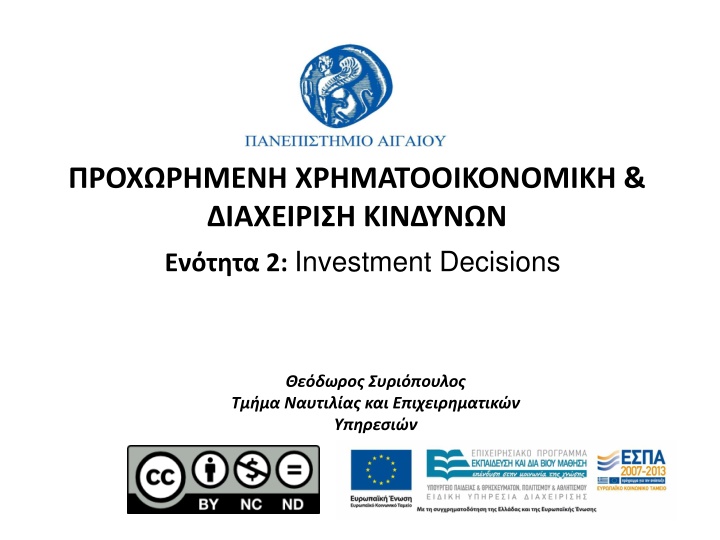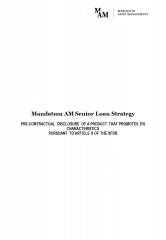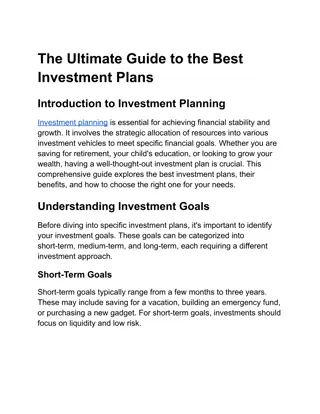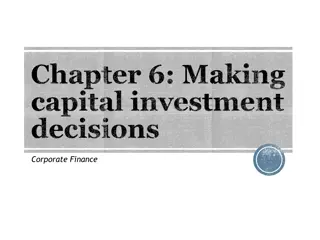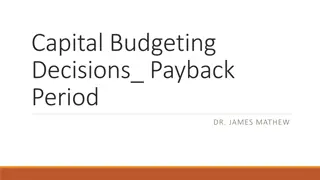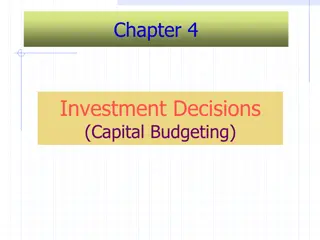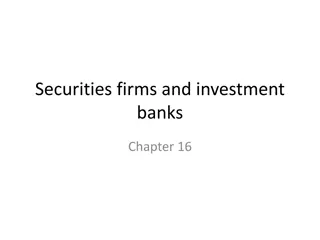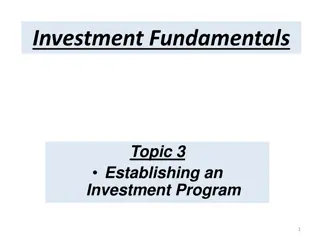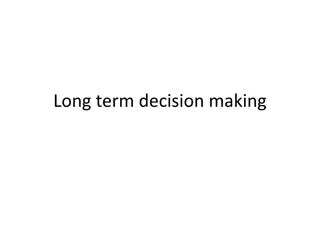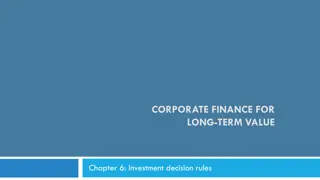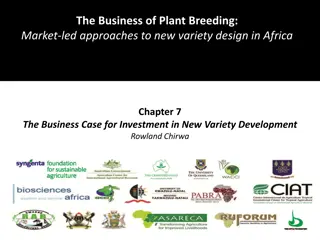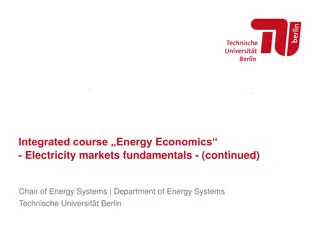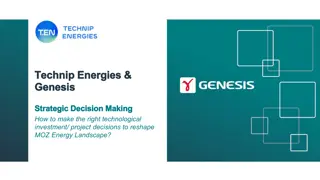Investment Decisions Tools and Techniques
Making investment decisions involves utilizing various tools and techniques to evaluate opportunities and risks associated with different financial options. From capital budgeting to discounting future cash flows, understanding the time value of money is essential in creating value for stakeholders and achieving financial objectives.
Download Presentation

Please find below an Image/Link to download the presentation.
The content on the website is provided AS IS for your information and personal use only. It may not be sold, licensed, or shared on other websites without obtaining consent from the author.If you encounter any issues during the download, it is possible that the publisher has removed the file from their server.
You are allowed to download the files provided on this website for personal or commercial use, subject to the condition that they are used lawfully. All files are the property of their respective owners.
The content on the website is provided AS IS for your information and personal use only. It may not be sold, licensed, or shared on other websites without obtaining consent from the author.
E N D
Presentation Transcript
& 2: Investment Decisions
University of the Aegean School of Business Studies Shipping, Trade & Transport Dpt. MA Shipping, Trade & Transport e-course Advanced Corporate Finance ADVFIN THEODORE SYRIOPOULOS Professor of Finance Department of Shipping, Trade & Transport School of Business Studies UNIVERSITY OF THE AEGEAN 2A, Korai street, 82100 Chios, Greece, Tel.: 22710 35 861, 6944 911 787 e-mail: tsiriop@aegean.gr http://www.stt.aegean.gr/SyriopoulosEn.asp
Background A Good investment decision raises current market valueof firm s equity thereby creating value for firm s owners . 6
Background A Capital budgeting involves comparing amount of cash spent on an investment today with cash inflows expected from it in the future 7
Background Discounting is the mechanism used to account for.. the time value of money converts future cash flows into today s equivalent value (called present value or discounted value) 8
Background Apart from the timing issue, there is also risk associated with future cash flows probability that cash flows to be realized in future may not be the expected ones 9
Time Value of Money assume we consider money is a commodity what is the PRICE of MONEY ??? 1 dollar TODAY 1 dollar TOMORROW ! only possible to compare or combine values at SAME POINT IN TIME ! 11
Time Value of Money Compounding Discounting the FUTURE value of a present amount of money the PRESENT value of a future amount of money PV FV FV PV 12
Time Value of Money receiving $1 today is worth more than $1 in the future this is due to opportunity costs opportunity cost of receiving $1 in the future is the interest we could have earned if we had received the $1 sooner Today Future 13
Compounding compounding translate $1 today into its equivalent in the future Today Future ? 14
Discounting discounting translate $1 in the future into its equivalent today Today Future ? 15
Present Value vs. Future Value When express the value in terms of dollars today Present Value (PV) of the investment When express it in terms of dollars in the future Future Value (FV) of the investment. 16
Basic Rules on Time Value of Money Financial decisions often require combining cash flows or comparing values 3 rules govern these processes 17
Future Value & Compounding General equation to find Future Value : n = + 1 ( ) FV PV k n where: FVn = PV = k n = future value of investment at the end of period n original principal (P0) or present value the rate of interest per period, which is often a year the number of periods = 18
Example: Future Value of 100 You leave 100 invested in the bank savings account at 10% interest for 5 years. How much would you have in the bank at the end of 5 years? ( 1 ) 5 = + FV 100 1 0 . 10 5 ( 1 ) 5 = 100 . 10 = 100 . 6105 = 161 05 . 19
Example on Compounding Problem What is the Future Value in 3-years of the following cash flows if compounding rate = 5%? 1 2 3 0 ? $2,000 $2,000 $2,000 20
Example on Compounding Solution 1 2 3 0 $2,000 $2,315 x 1.05 x 1.05 x 1.05 $2,000 $2,205 x 1.05 x 1.05 $2,100 $6,620 $2,000 x 1.05 or 1 2 3 0 $2,000 $2,000 $2,000 $2,100 x 1.05 $4,100 $4,305 $6,305 x 1.05 $6,620 x 1.05 21
Present Value & Discounting General equation to find Present Value FV n = PV n + (1 i) 1 + 1 Discount Factor r= = 0.93458 1 1.07 22
Present Value & Discounting Suppose you are interested in buying a BMW 330 Sports Coupe a year from now. You estimate that the car will cost 40 000. If your local bank pays 5% interest on savings deposits, how much will you need to save to buy the car? 40 + 000 = PV 1 . 0 05 = 38 095 . 24 23
Present Value & Discounting The further in the future the money will be received, the less it is worth today The higher the discount rate, the lower the present value of money 24
The Capital Investment Process Capital investment decision (capital budgeting decision, capital expenditure decision) involves four steps: identification evaluation selection implementation audit 26
The Capital Investment Process Investment proposals are also often classified according to the difficulty in estimating the key valuation parameters required investments replacement investments expansion investments diversification investments 27
Net Present Value Rule for Value Creating Investments
A One-Period Investment Investment Problem: How much should we invest now in a savings account with a 6% interest rate . if we want to receive $11,000 in 1-year? 30
A One-Period Investment Answer: $ 11.000 x (1/(1+0,06)1) = $11,000 x 0.9434 = $10,377 discount RATE = k discount FACTOR = 1/(1 + k)n Inversely: $10,377 + $10,377 x 6% = $11,000 or 11,000 1.06 = $10,377 31
A One-Period Investment at 6%... we should be indifferent between $10,377 now vs. $11,000 in 1-year at 6%... the two cash flows are equivalent 32
A One-Period Investment The difference between Present Value of future cash flow & initial outlay is called the Net Present Value (NPV) 33
Cash-Flow Time Line : 1-period project Timeline: linear representation of the timing of potential cash flows Drawing timeline of cash flows helps visualize the financial problem CF1 = interest rate: 10% CF0 = Case: 1 - investing $10,000 in a parcel of land now; expectation: it could be sold for $11,000 next year; expected return on this investment = 10% - if more than 10% can be earned on a comparable or alternative investment, we should NOT buy the land. 34
Time Line for Multiple-Period Investments The General Case Case 2 illustrates the case of a multiple-period investment & presents the general NPV formula 35
Valuing a Stream of Cash Flows Present Value of a Cash Flow Stream: C N N n n = = ( ) (1 n PV PV C n + n ) r 0 = 0 = 36
Decomposing the NPV Rule = (Benefits) (Costs) NPV PV PV = (All project cash flows) NPV PV 37
NPV Rule NPV > 0 ACCEPT investment if: REJECT investment if: NPV < 0 INDIFFERENT investment if: NPV = 0 39
Case Study Sunlight Manufacturing Company 40
Applying NPV Rule to a capital investment decision NPV application - industrial investment project: Case: Sunlight Manufacturing Company considers adding a new product to its existing line assumption: inputs have already been estimated (i.e.investment cash flows & cost of capital) 41
Case Study: Sunlight Manufacturing Company Investment Project: adding a new product to existing line 9 42
Calculation of PV for Sunlight Manufacturing Company Case study: Sunlight Manufacturing Company considers adding a new product to its existing line : Initial Capital Outflow = $ 10,000,000 Investment horizon = 5 - years Cash-flow stream: CF1 = $ 8,320,000 CF2 = $ 8,220,000 CF3 = $ 6,920,000 CF4 = $ 5,540,000 CF5 = $ 4,660,000 discount rate = 9% 43
Calculation of PV for Sunlight Manufacturing Company 1 Present value of CF1 = $8,320,000 = $8,320,000 0.9174 = $7,633,028 (1 + 0.09)1 1 Present value of CF2 = $8,220,000 = $8,220,000 0.8417 = $6,918,610 (1 + 0.09)2 1 Present value of CF3 = $6,920,000 = $6,920,000 0.7722 = $5,343,510 (1 + 0.09)3 1 Present value of CF4 = $5,540,000 = $5,540,000 0.7084 = $3,924,675 (1 + 0.09)4 1 Present value of CF5 = $4,660,000 project cash-flows = $4,660,000 0.6499 = $3,028,680 discount factor (1 + 0.09)5 Total Present Value at 9% $26,848,503 discount rate cumulative present value Net Present Value (NPV) $16,848,503 Initial Ouflow CF0 = - $ 10,000,000 44
Why NPV rule is a Good Investment yardstick NPV rule is a good investment rule because: measures value creation reflects timing of project s cash flows takes into account project risk additivity property 47
Adjustment for Riskof projects cash flows Risk adjustment is made through the project s discount rate because investors are risk averse they will require a higher return from riskier investments 48
NPV vs. discount rate NPV inverse relationship by discountingthe project cash flows at a higher rate the project s NPV will decrease NPV1 NPV2 discount rate r1 r2 r2 > r1 NPV2 < NPV1 49
Cash Flows for 2 investments with CF0 = $1 mln. k = 0.12 Investment C - k = 0.15 Investment D END OF YEAR INVESTMENT C INVESTMENT D 1 CF1 = $300,000 CF2 = 300,000 CF3 = 300,000 CF4 = 300,000 CF5 = 300,000 CF1 = $300,000 CF2 = 300,000 CF3 = 300,000 CF4 = 300,000 CF5 = 300,000 2 3 4 5 Total Cash Flows $1,500,000 $1,500,000 2 investments - same initial cash outlay - same cumulative cash flows - same cash flow profile BUT:different cost of capital 50
